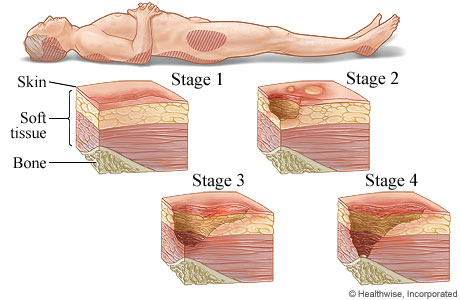Stages of pressure injuries
Stages of pressure injuries

Pressure injuries are injuries to the skin and underlying tissue. They can range from mild reddening of the skin to severe tissue damage—and sometimes infection—that extends into muscle and bone. Pressure injuries are described in the following stages.
- Stage 1 pressure injuries are not open wounds. The skin may be painful, but it has no breaks or tears. The skin appears reddened and does not blanch (lose color briefly when you press your finger on it and then remove your finger). In a dark-skinned person, the area may appear to be a different color than the surrounding skin, but it may not look red. Skin temperature is often warmer. And the stage 1 injury can feel either firmer or softer than the area around it.
- Stage 2 pressure injuries are open wounds. The skin breaks open, wears away, or forms an ulcer, which is usually tender and painful. The wound expands into deeper layers of the skin. It can look like a scrape (abrasion), blister, or a shallow crater in the skin. Sometimes this stage looks like a blister filled with clear fluid. At this stage, some skin may be damaged beyond repair or may die.
- Stage 3 pressure injuries extend through the skin into deeper tissue and fat but do not reach muscle, tendon, or bone.
- Stage 4 pressure injuries extend to muscle, tendon, or bone.
- Unstageable pressure injuries are when the stage is not clear. In these cases, the base of the wound is covered by a layer of dead tissue that may be yellow, gray, green, brown, or black. The doctor cannot see the base of the wound to determine the stage.
- Deep tissue pressure injuries are when there isn't an open wound, but the tissues beneath the surface have been damaged. The area of skin may look purple or dark red, or there may be a blood-filled blister. If you or your doctor suspect a pressure injury, the area is treated as though a pressure injury has formed.
Serious complications, such as infection of the bone (osteomyelitis) or blood (sepsis), can occur if pressure injuries progress.
Current as of: November 16, 2023
Author: Ignite Healthwise, LLC Staff
Clinical Review Board
All Healthwise education is reviewed by a team that includes physicians, nurses, advanced practitioners, registered dieticians, and other healthcare professionals.
This information does not replace the advice of a doctor. Ignite Healthwise, LLC, disclaims any warranty or liability for your use of this information. Your use of this information means that you agree to the Terms of Use. Learn how we develop our content.
To learn more about Ignite Healthwise, LLC, visit webmdignite.com.
© 2024-2025 Ignite Healthwise, LLC.
This information does not replace the advice of a doctor. Ignite Healthwise, LLC, disclaims any warranty or liability for your use of this information. Your use of this information means that you agree to the Terms of Use. Learn how we develop our content.

